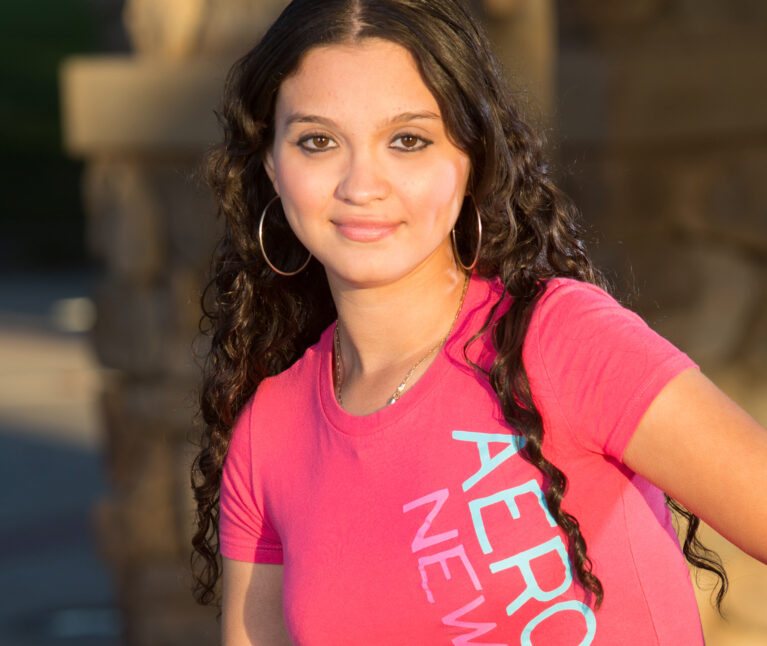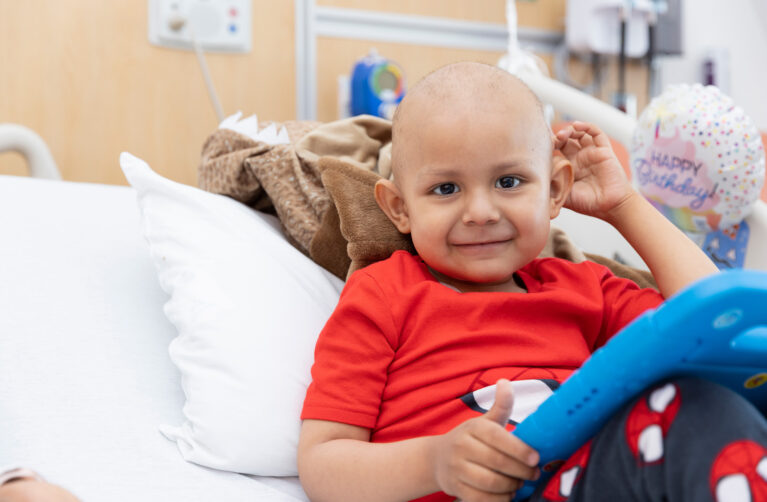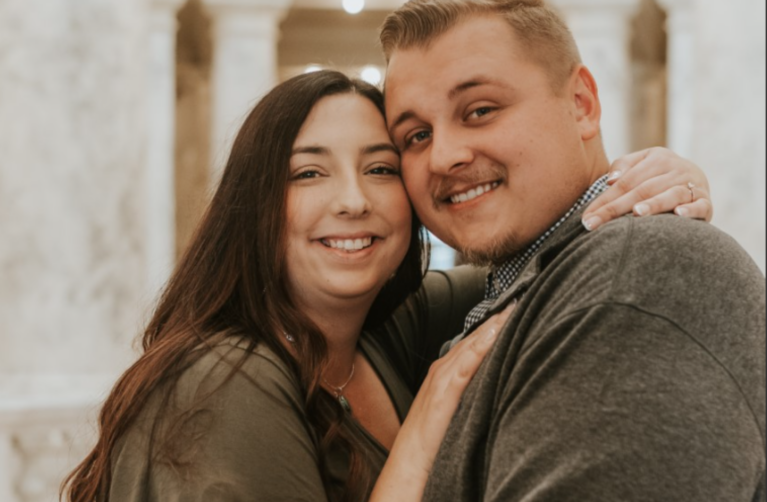Meet Karina
Karina Barreto-Delgado was sitting in her high school English class on a typical Friday morning, taking a test, when the call came. For six months, the 15-year-old resident of Visalia, Calif., had been on the national organ registry, waiting for a new liver and kidney. Now, in the fall of 2009, she and her parents were in the car, speeding past the orchards on Route 99 toward Lucile Packard Children’s Hospital, more than 200 miles away.
For as long as she could remember, Karina had been battling with methylmalonic acidemia, a genetic disease in which the body is unable to process certain proteins and fats properly. Since infancy she had been in and out of the hospital — vomiting, dehydrated, feverish and weak. The only treatment, prior to a combined liver-kidney transplant, was a severely restricted diet that included no protein or potassium.
“I was pretty much on noodles and rice,” she recalls. Eventually I started losing muscle from my legs down, and I was disabled for a while. I couldn’t get around without a walker.”
As she checked into the hospital, Karina felt frightened. News of the organ donor match had caught her off guard, and everything was happening so quickly. But as the staff in the Pediatric Intensive Care Unit calmly swung into action, she began to settle down.
“I remember I was sitting on the bed, looking at my mom, crying and praying so much,” she recalls. “Then I just remember feeling kind of woozy and tired, and I was asleep. That was a Friday afternoon. When I woke up it was Sunday.
”Karina’s transplant surgery, which started at 3:40 a.m. on Saturday, occurred in two parts: first, a team led by Carlos Esquivel, MD, PhD, transplanted the liver, which took about four hours. Then a team led by Waldo Concepcion, MD, FACS, took over and spent the next three hours transplanting the kidney.
After the surgery, Karina spent two and a half weeks recovering at Packard Children’s, followed by two more months living nearby at the Ronald McDonald House. Today, with her precious new liver and kidney, plus lots of physical therapy, the 19-year-old is walking again without any assistance at all. She also can eat pretty much anything she wants, as long as it’s low in protein. Her favorite food? “Potatoes,” she says, laughing. “They’re my all-time favorite vegetable.”
A Storied History
Stanford surgeons have been performing organ transplants since 1960, when a team led by Roy Barnett Cohn, MD, performed the first successful kidney transplant in the western United States. The 47-year-old male patient received a kidney from his twin brother and spent two months recovering in the hospital.
Today, surgeons at Packard Children’s safely and routinely transplant kidneys and livers into some of the sickest, smallest children. Intestinal and multi-organ transplants like Karina’s have progressed from experimental procedures to lifesaving therapies. Nearly all pediatric transplant patients are out of the hospital within weeks, and their chances for long-term survival are excellent. According to data released in 2012, Packard Children’s pediatric kidney and liver transplant programs both achieved 100-percent survival rates for patients one year post-transplant. They also have one-year organ graft survival rates of over 98 percent, compared to 89 percent nationally.
Perhaps the greatest key to this success is teamwork. Back in 1995, when Packard Children’s launched its abdominal transplant programs, the hospital recruited a stellar group of surgeons, physicians, and support staff who had been training and working together for more than 10 years at the University of Pittsburgh and California Pacific Medical Center in San Francisco. Among the prominent additions to the Packard team were Oscar Salvatierra, MD, professor emeritus and past director of Pediatric Kidney Transplantation; Esquivel, the Arnold and Barbara Silverman Professor in Pediatric Transplantation and chief of the division of transplantation; and Concepcion, professor of surgery and now director of Pediatric Kidney Transplantation.
In Concepcion’s opinion, bringing together such a well-oiled, nationally recognized team “was the smartest decision ever. Instead of reinventing the wheel, Packard Children’s Hospital said, ‘Let’s bring in a group of people who already know how to do it, and have them foster an environment of success here.’”
Today, he says proudly, “Whenever we have a transplant, you don’t even have to blink; there’s a system already in place. It’s a whole institutional thing. We have an outstanding medical staff, dedicated operating rooms for pediatric transplant, dedicated anesthesia — that’s huge — and dedicated people in the pediatric intensive care unit who work with us consistently. Why is that important? Patterns of care — everybody knows what we are thinking and what we are expecting, and we communicate efficiently. Everybody should be excited about having a transplant program like this.”
Making the Call
In a cramped office building on Welch Road across from the hospital, Gerri James, RN, BSN, CCTC, is making yet another phone call. Packard Children’s has the highest volume of pediatric kidney transplants in the country, and on any given day, the lead kidney transplant coordinator might have to keep track of 100 children who are waiting for transplants or evaluations.
“There’s a lot going on!” James says with a gentle laugh. “I am often the first person that the parents hear from when their children are referred for transplant. It’s always a stressful time, but my job is to tell them, ‘Rest assured, we are going to make this as easy as it can get. We are on your side and are going to help you through it.’”
In addition to acting as liaison between referring physicians and Packard Children’s, James and her counterpart, Debra Strichartz, RN, BA, CCTC, liver transplant program manager, help families line up all the support they will need, from insurance companies and pharmacists to medivan drivers and therapists. They also play a key role in educating the families — often through translators — about what to expect before, during, and after surgery.
When families are worried or discouraged about the wait for a donor organ, James and Strichartz are there around the clock to answer questions and provide encouragement. When donor organs finally do become available, it’s their privilege to phone with the news.
“No matter how tired you are—and the calls rarely come during the day — it’s super exciting,” James says. “On the one hand, you realize, ‘Wow, this is a terrible loss for the donor family.’ But on the other hand, you see all the good that comes out of it.”
Just the other day, at Packard’s nephrology clinic, James ran into one of her most recent success stories: a strawberry blond 2-year-old named Sydney Walter. Sydney’s family previously lived in Hawaii, and while she was still in utero, doctors determined that her kidneys were damaged by a blockage in the flow of urine. For the first few months of her life, they were able to help her with medication, but eventually it became clear that Sydney would need dialysis and a transplant.
Seeking the best care possible, the military family packed up its belongings in Oahu and moved to California to be near Packard Children’s. Sydney was put on lifesaving dialysis for a year until she could grow to the ideal weight. Meanwhile her mother, Brittany, who would be Sydney’s organ donor, was recovering from the birth of Sydney’s little sister. Finally, in August 2013, when Concepcion transplanted mom’s healthy kidney into Sydney, everything went like clockwork.
“They told us to expect to be in the hospital two or three weeks minimum, but Sydney was only in the hospital eight days,” Brittany marvels, just a month after the transplant. “We had great family support; an awesome team.”
“It takes a village,” notes Paul Grimm, MD, medical director of the kidney transplant program. Sydney’s care before, during, and after transplant involved nephrologists, nurses, nutritionists, social workers, psychologists, transplant pharmacists, surgeons, and many more crucial players. “We have a large and dedicated team that lives and breathes this work, and we get to celebrate with children as they grow up,” Grimm adds.
Down the road, Sydney will need to see an occupational therapist at Packard Children’s to help her learn to eat solid foods; like many young transplant patients, she has been depending on a feeding tube to provide her with enough liquids to keep her new kidney healthy. She’ll also have to take immunosuppressant drugs for the rest of her life.
“She’s doing great,” Brittany says, “She’s just at the age where she is interested in princesses and tea parties. And she loves to be outside, climbing all over the place.”
On the Road
While the Walters were able to move to California, many other families can’t relocate. That’s where Packard Children’s transplant outreach clinics can help. Several times each year, physicians and nurse coordinators from the kidney and liver programs travel to cities throughout the western United States, from Sacramento and Portland to Las Vegas and Honolulu. At each outreach site, they can check on referred patients and follow up with those who’ve already had surgery.
“We’re like a road show,” says Strichartz. “If someone is being referred to us, we can assess where they are on the spectrum: Are they ready for a transplant, or can they be managed medically before going on the list? Also, we see the patients with their local doctor. Best of all, the families get to meet us before they come to the hospital for transplant, so we can start our education process early.”
One of Strichartz’s most memorable liver transplant patients was an impish 2-year-old Bakersfield boy who loved dinosaurs. Jackson Vaughan’s first sign of trouble was small: a bump on the right side of his abdomen. But when a family physician took a look at it, he promptly arranged for the little boy to be seen at Lucile Packard Children’s Hospital.
“Within 10 minutes of the first doctor feeling his abdomen, we learned that Jackson had an advanced, very large tumor,” his father, Jeff Vaughan, recalls. “That started the roller coaster downhill.”
Over the next few months, Jackson underwent chemotherapy at Packard Children’s while endearing himself to the doctors and nurses in the oncology unit. Once the cancer had retreated, his medical team agreed that a full liver transplant would be the best way to ensure his survival.
“Most places would not give an organ to somebody with such advanced cancer,” Jeff marvels. “But the core team, led by Drs. [Kenneth] Cox and Esquivel, really fought for him.”
Unfortunately, Jackson’s tiny body rejected his first liver transplant, and when he was put on a machine to replicate the liver’s functions, his blood pressure dropped precipitously. For 36 long minutes, doctors in the pediatric intensive care unit struggled to restore Jackson’s heartbeat. A final jab of epinephrine to the heart did the trick. Miraculously, numerous follow-up tests showed no brain damage, and Jackson was cleared for yet another transplant.
This time, it worked.
Today, the tousle-haired 13-year-old is thriving in the eighth grade, with a 4.0 grade point average, a killer pitching arm, and dreams of being a professional baseball player. He doesn’t remember much about the hospital — other than the frozen yogurt machine. But he’s sure that his drive to excel comes largely from his time at Packard Children’s.
“My experience made me an underdog,” Jackson says, thoughtfully. “I like that, because you can show people what you can do — outsmart them all.”
More to Come
Looking forward, Packard Children’s transplant specialists hope to build on their reputation for excellence and innovation to ensure even better outcomes for children. To minimize wait times for donor organs, for example, Esquivel has developed novel surgical techniques for splitting adult livers. This allows for two transplants, with the larger right lobe going to an adult, and the smaller left lobe to a child. “
Our next steps,” he says, “involve using donor stem cells to induce tolerance for the new organs, creating an artificial liver as an external backup system, and developing better mechanisms for preserving the organ before it is transplanted.”
As for kidney transplantation, Packard specialists were among the first to successfully transplant adult-size donor organs into infants. They were also the first to suppress organ rejection without the use of steroids. In addition, these specialists are able to desensitize the immune systems of patients who otherwise have a very low likelihood of finding a compatible kidney. There is also work being done to help infants and children with abnormal urinary tracts avoid renal failure and transplants altogether. Another exciting development on the horizon is the use of genetic profiling to determine a child’s inherited likelihood of organ rejection, and to tailor post-transplant medications.
Finally, there’s that perennial challenge: teenagers. About 60 percent of transplant patients at Packard Children’s are adolescents, and unless they take ownership of their new organs, and agree to follow their post-transplant medication regimens faithfully for the rest of their lives, all the good work done in the hospital can be undone.
“That’s one of the most difficult aspects of our work: ensuring compliance,” says Concepcion, who is himself a father of three adult daughters.
To solve this problem, Packard Children’s offers a unique teen clinic that prepares adolescents to assume responsibility for their health as they juggle relationships, school, and work. “Hopefully we also can develop more long-acting medications with fewer side effects,” Concepcion adds. “This, more than anything, will improve their quality of life.”
Meanwhile in Visalia, potato-lover Karina Barreto-Delgado is almost out of her teen years now. So is her younger brother, Angel, who in November 2012 also received a combined liver-kidney transplant at Packard Children’s for the same genetic disease. This fall, he celebrated his 17th birthday.
“He’s a senior in high school now, doing pretty good,” the 19-year-old says proudly. “My own graduation ceremony, from San Joaquin Valley College, was just last week.” Karina’s dream job? To be a medical assistant at Children’s Hospital Central California — working with kids who have kidney and liver problems, just like she did.
This article appeared in the Lucile Packard Children’s News publication in Fall 2013.



